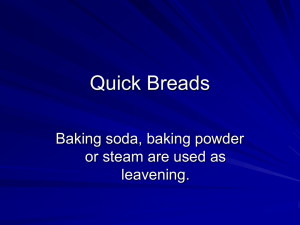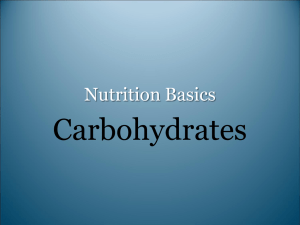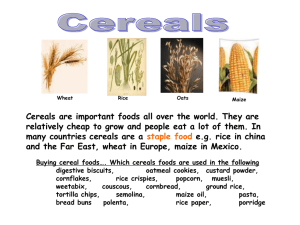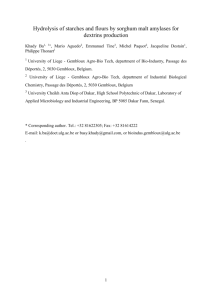Cereal Grains, Legumes & Oilseeds
advertisement
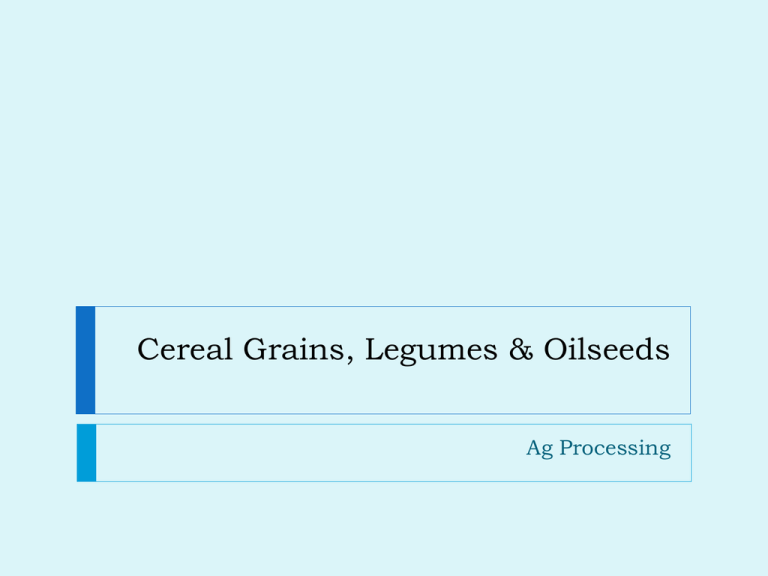
Cereal Grains, Legumes & Oilseeds Ag Processing Cereal Grains Many types Markets have expanded their range of uses General Structure and Composition Outer bran coat 5% of the kernel Cellulose Minerals and some vitamins Aleurone layer 8% of the kernel Lies just under the bran coat Rich in protiens, phosphorus and thiamine Endosperm 82% of the kernel Large, central portion of the kernal Contains the most starch Also contains most of the protien but has very little mineral or fiber Germ Small Rich in fat, protein, minerals also contains most of the riboflavin Cereals Processed grains that are generally 75-80% carbohydrates Fiber is also an important attribute Bran cereals may contain 10-26 grams of fiber per cup Contain both soluable and insoluable fiber Insoluable fiber is good for the digestive tract and helps reduce the risk of certain cancers Soluable fiber- lowers blood cholesterol, originates in the endosperm and is found in oats, legumes, fruits and vegetables Starch Starch Storage form of carbohydrate deposited as granules or aggregate of granules in the cells of plants Size and shape of the granules differ from various sources Parts of the plant that serve most prominently in the storage of starch are: Seeds—cereals and legumes Roots and tubers—parasnips, potatoes, sweet potatoes Cassava root—Tapioca Pith of the Tropical palm--Sago Starch Make-up Granules are made up of many starch molecules arranged in an organized matter Two types Amylose Amylopectin Amylose Polysaccharide of glucose Contributes gelling characteristics to cooked and cooled starch mixtures Amylopectin Highly branched polysaccharide of glucose Provides thickening properties but does not usually contribute to gel formation Most starches are a mixture of the two Milling of Grains History of Milling Stones, wood were used by primitive people Led to water driven mills with large mill stones Modern milling replaced the mill stone with rollers Flour Milling Bran covering, germ and endosperm are seperated to a desired extent Endosperm is pulverized Middlings (inner portion of the kernel) is fed through a series of smooth rollers after being seperated from the bran to further reduce the size of the particles and produce a finer flour 6-8 streams of flour are produced from the rolling and sifting of the purified middlings, this results in various grades and types of flours. They vary in bran, germ and gluten content White Flour Final production step is often bleaching and/or maturing Freshly milled unbleached flour is yellowish in color when used for baking produces a fairly course textured loaf If the flour is stored for several months the color lighten and the baking qualities improve FDA approves the use of nitrogen trichloride and nitrogen tetroxide, chlorine dioxide, benzyl peroxide, acetone peroxides, & azodicarbonate to bleach and mature flour The flour then must be bleached Flour Composition Depends On Class of wheat used Conditions under which the wheat is grown Degree of fractionation Classes of Wheat Hard, Soft, Durum Durum is used almost exclusively for producing semolinagranular flour of high gluten content and is in the manufacturing of macaroni products Hard Red Spring Durum Hard Red Winter Geographical Production Areas Hard Spring Wheats Hard Winter Wheats South Central and Middle Central States Soft Winter Wheats North Central US, Western Canada East of the Mississippi River and Pacific Northwest Climatic and soil conditions affect the composition of wheat, wide varations may occur within the classes http://www.smallgrains.org/WHFACTS/growreg.htm Grades of Flour Based on the four streams used to make them Straight grade should contain all of the four streams resulting from the milling process However 2-3% of the poorest streams is withheld and very little flour on the market is straight grade Patent flours come from the more refined portions of the endosperm & may be made from any class of wheat and are divided as followed in order of quality First Patent Second Patent First Clear Second Clear Red Dog Types of White Flour Bread Flour All-Purpose Flour Less strong and elastic gluten than bread flour May be a blend of hard and soft wheat or entirely hard or soft winter wheats Pastry Flour Slightly higher percentage of gluten and a much stronger and more elastic gluten than other types of flour Made chiefly from hard wheat Made from soft winter wheat Contains a weaker quality of gluten and a slightly lower percentage of gluten than bread and all purpose flours Cake Flour Specially prepared to reduce the gluten content about 7% Best made from soft wheat Finely ground Highly bleached with chlorine Enriched Flour White flour to which specified B vitamins and iron have been added Calcium and vitamin D may also be added Enrichment of bakers white bread and rolls was made compulsory by the federal government in 1941 as a war measure to improve the nutritional status of people After the war, enrichment became voluntary Gluten 85% of the protiens of white flour are insoluable Separate into two fractions Gliadin—syrupy substance that may bind the mass together Gutenin—exhibits toughness and ruberiness that contribute to strength Together they form gluten Other Flours Cornmeal Corn flour Used for making extruded cereals, cakes, cake donuts, cookies and crackers Oat flour Used to make commercial pancake mixes Barley flour Used to make quick breads Not common Cakes, cookies, crackers Rice flour Used in many products as a substitute for those who have an allergy to wheat Cannot be used in products that require gluten Basically rice starch Corn Refining Corn Refining Leading example of value added agriculture 1.2 million bushels of corn are used to produce for the world market Refiners separate shell corn into its components Food Industrial and feed products Starch Oil Protein Fiber Convert them into higher value products Inspection and Cleaning Upon arrival the corn is inspected and cleaned twice to remove cob, dust, chaff and foreign materials Corn Refining See handout Steeping Corn is soaked for 30-40 hours in 50 degree F water Moisture level of the corn is increased from 15 to 45% More than doubles in size Mild acidity of the steep water begins to loosen the gluten bonds and release starch Corn is coursely ground after steeping to break the germ loose Steepwater is condensed to capture nutrients for use in animal feed and for use in later fermentation processes Ground corn in a water slurry goes to the germ seperators Germ Separation Cyclone separators spin the corn germ out of the slurry Germs are pumped onto screens and washed repeatedly to remove starch Mechanical and solvent processes are used to extract the oil from the germ 85% of the oil in the corn is found in the germ Oil is then refined and filtered into finished corn oil Germ residue is saved as another component of animal feed Fine Grinding and Screening Corn and water slurry are ground a second time in an impact or attrition impact mill after leaving the germ seperator This releases the starch and gluten Suspension of starch, gluten and fiber flows over concave screens that catch fiber but allow starch and gluten to pass through Fiber is collected, slurried and screened a second time to reclaim residual starch or protien then sent to the feed house where it is used as a major ingredient in animal feeds Starch-gluten suspension called mill starch is piped to the starch seperators Starch Separation Mill starch is passed through a centrifuge where the gluten is spun out for use in animal feeds Starch is diluted, washed 8-14 times, rediluted and washed again to remove protiens to produce high quality starch that is more than 99.5% pure Starch is dried and marketed in one of the following forms Unmodified corn starch Modified speciality starch Corn syrup and dextrose (most) Syrup Conversion Starch suspended in water is liquified in the presence of acid and/or enzymes that convert the starch to a low dextrose solution Treatment with another enzyme continues the conversion process Throughout the process refiners can halt acid or enzyme actions at key points to produce the right mix of sugars like dextrose and maltose for syrups that meet different needs For example: To produce low to medium sweetness syrups starch to sugar conversion is halted at an early stage In others the conversion is allowed to continue until the syrup is nearly all dextrose. The syrup is then refined in filters, centrifuges and ion-exchange columns and excess water is evaporated. Syrups are then sold directly, crystallized into pure dextrose or further processed to create high fructose corn syrup Fermentation Dextrose is one of the most fermentable sugars Following the conversion of starch to dextrose many corn refiners pipe dextrose to fermentation facilities where the dextrose is turned into alcohol After fermentation the resulting broth is distilled to recover alcohol or concentrated through membrane separation to produce other bio-products. Carbon dioxide from fermentation is recaptured for sale and nutrients remaining after fermentation are used as componenets of animal feed ingredients. Bioproducts Ethanol Organic acids Amino acids-used in animal nutrition Vitamins Food gums Citric and lactic acids Plastics Eco-foam packing peanuts Legumes Legumes Provide protien and energy to much of the world’s population Found almost everywhere in the world Common Legumes Alfalfa Beans Kidney, Navy, Pinto, Snap Cowpea Chickpea Field pea Garden Pea Lentil Lima Bean Peanut Soybean Nutritional Composition Good sources of Carbohydrates Fats Proteins Minerals Vitamins Mixtures of legumes and grains have a protein quality that comes close to that of animal protein Legume Products Fermented Foods Flours Soybean flour (used to make soy milk and low-gluten baked foods) Imitation meat Infant formulas Oil Soysauce, tempeh, tofu Soybean and peanut Sprouts Assignment Design a poster showing all the products that can be made from soybeans. Show pictures of these products and give a description of them.
